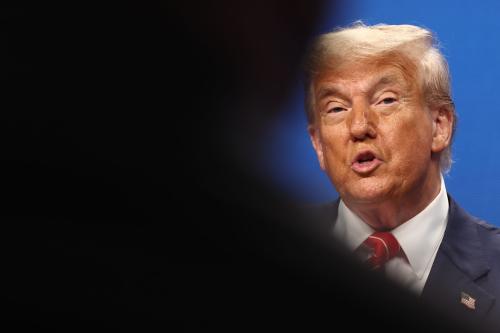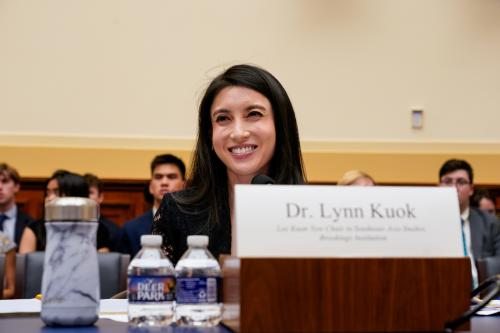When President Bush and South Korean President Roh Moo-hyun meet at the White House on September 14th, they are likely to highlight an obscure issue that has received absolutely no attention in the American press or policy community. That is unfortunate, for it foreshadows a shift in our alliance that is being made for questionable reasons and will arguably weaken the security of the Republic of Korea.
The obscure issue concerns the future of the Combined Forces Command (CFC), the organization that currently answers to the South Korean and American National Command Authorities in wartime. The CFC is currently commanded by a US four-star General.
Ever since the Korean War, the allies have agreed that the American four-star would be in “Operational Control” (OPCON) of both ROK and US military forces in wartime at the operational level of war in a tightly integrated command structure, answering directly to the national command authorities of both nations. This is a bilateral arrangement, and the leaders of both nations have the strategic option of not allowing their military forces to participate in any given wartime operation. Before 1978, this was accomplished through the United Nations Command. Since then it has been the CFC. Since 1994, the South Korean military has had peacetime control of its own forces in a structure separate from CFC. Designated ROK forces do not come under the wartime OPCON of CFC until the South Korean President (presumably with the advice of his Minister of National Defense) designates that they do so.
Roh’s government has been pushing for “self-reliant” national defense. Most significantly, President Roh has proposed, and the United States has agreed in principle, that wartime operational control (“OPCON”) will eventually no longer belong to CFC, but instead the South Korean and US militaries will fight under separate, independent commands during wartime. Discussions have already begun to create arrangements to implement the transfer.
President Roh’s proposal has a certain rationale. It reflects a desire to restore full sovereignty to the ROK and to bolster national pride. The problem with the idea is very practical, that changing “wartime OPCON” may unintentionally reduce the security of South Korea. It would inevitably mean the dissolving the CFC and perhaps lead to the end of the U.S.-ROK alliance itself, both of which have successfully deterred North Korea since 1953.
The reason is that wartime control of both the US and South Korean forces under a combined structure commanded by an American general – who answers to the Presidents of both nations – is like the keystone of an arch. OPCON is tied to a host of other institutions – war plans, specific command arrangements, allotment of roles and missions – that have been developed over decades. For example, South Korea has not had to perform certain missions because the U.S military has been responsible for them and has the capabilities to do so (and the ROK military does not). Capabilities and institutions fit together to create a formidable deterrent against a North Korean attack and an impressive array of war-fighting capabilities should deterrence fail.
But try to change the keystone and the arch will crumble. Most or all the elements of deterrence and war-fighting structure will have to be adjusted, some perhaps in fundamental ways. This is a process that will take several years to implement effectively. The urge to transfer wartime OPCON, however well-meaning, has gotten ahead of a review of all its implications. The keystone is being replaced before we and the South Koreans understand fully what is going to happen to the arch.
Ironically, President Roh’s desire to restore this element of perceived sovereignty has played into the hands of some Americans who reportedly wish to radically reduce the American military presence on the Korean peninsula. Indeed, the US Department of Defense has reportedly proposed that the transfer occur in 2009, three years ahead of what the South Korean government originally proposed. Most military expert analysts would agree that 2009 is far too soon for the ROK military to make needed upgrades to weapons systems, planning, and re-organization of forces that would provide the same capabilities that the CFC structure currently provides. Such a move would also make South Korea more vulnerable to both limited and large-scale acts of aggression by North Korea.
An agreement to transfer wartime OPCON in 2009, as reportedly suggested by DOD, likely has the perverse effect of denying the South Korean people an opportunity to render a judgment on this proposal, one that has profound consequences for their security. With less than eighteen months left in office, President Roh is very unpopular, and his wartime-OPCON proposal is one reason. If a candidate of his ideological persuasion, emphasizing the strengthening of national sovereignty, were to get elected late next year, that would be confirmation that the South Korean public supported the wartime OPCON transfer. It could happen. But if the candidate of the conservative opposition running on a security-first platform were to win, it would signal among other things that the public wanted a reconsideration of transferring wartime OPCON. The problem, of course, is that a prior, U.S.-pressured decision to make that transfer in 2009 would by then be irreversible. The interests of those who have most at stake – the South Korean people – would have been ignored. Far better to set a later date so that a new Seoul leadership has an opportunity to review the basic proposal and the ROK military has more time to build the capabilities it needs under the new command arrangements if they should become necessary.
Transferring wartime OPCON to two parallel, independent structures may not be the worst idea to come along in U.S.-ROK relations. But if it is to be done, it should be done for the right reason. And it should occur at a gradual pace and with full preparation, in order to ensure that the security of the people of South Korea is not put at risk and that the transition strengthens the alliance rather than undermines it.
The Brookings Institution is committed to quality, independence, and impact.
We are supported by a diverse array of funders. In line with our values and policies, each Brookings publication represents the sole views of its author(s).



Commentary
Change of U.S.-ROK Wartime Operational Command
September 14, 2006